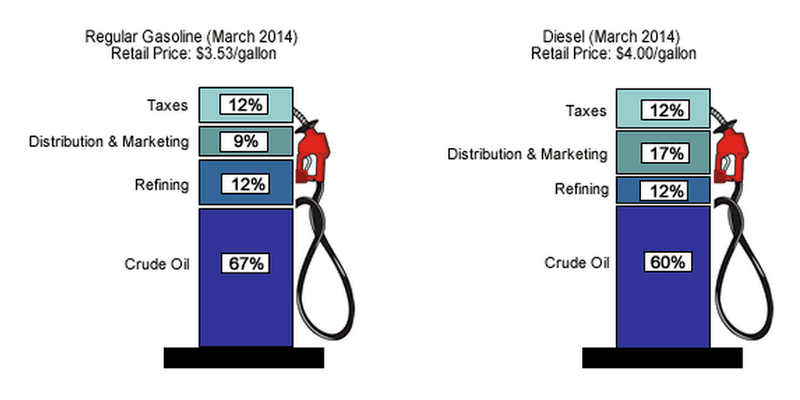This post comes from my long time friend and college instructor Andrew Levin.
Here in the USA, we love our gas. Each day, we consume enough gasoline to fill up over 550 Olympic-sized swimming pools. There is an average of one car for every two Americans. And boy do we like to drive. According to the US Department of Transportation, each American driver drives an average of 15,000 miles per year.
Given our dependence on ‘Texas Tea’, it is not surprising that we tend to get riled up when there is quarter-dollar rise between fill-ups. Even with a fuel efficient, compact vehicle that small rise would remove over $100 from our pocket books each year!
So – why does the oil market fluctuate so much and why is gas so expensive?
How gas is priced
According to the US Department of Energy, 67% of your tank of gas is the oil itself. The rest is refining (12%), distribution/marketing (9%), and taxes (12%). Pricing of oil is done through commodity markets and based on specific types of oil. Worldwide there are 5 main types of oil, and thanks to arbitrage, these prices have converged (or nearly so) into a single world oil price. Like Forex, prices are based on both current supply and demand and expectations for how these might change in the future.
On the demand side, it has traditionally been assumed that Americans would continue to use more fuel. However, the Great Recession has changed us. We are driving fewer miles in more efficient cars. Mind you, we still use 8 million barrels of oil each year (those 550 swimming pools-worth), but the expected demand has flattened.
On the supply side expectations can matter a lot in pricing. Here in Chicago gas must be made using a special low-emission blend. However, only two refineries have the capability of making this recipe. When one of these refineries was shut down last year, the price rose around half a dollar. While there was plenty of already-refined oil lying around, there was an expectation that supply would eventually tighten if the refinery remained closed. In the end, the refinery reopened quickly. Thus, supply was never actually affected, but Chicagoan’s wallets sure were!
Geopolitics at the Pump
Expectations can at times lead to speculation when dealing with global uncertainty. Such speculation does not usually lead to drastic changes in prices. However, there is nothing preventing spikes from occurring due to conflicts or political instability. The biggest ones were in the 1970s, when oil more than quadrupled!
Countries sometimes even bend their foreign policy to minimize these risks. You may have heard about “Arab Spring”. This political uprising across authoritarian regimes in much of the Middle East has been largely supported by the US. With that said, US government support for the uprising seems to end at the border with Saudi Arabia. While it provides less and less oil directly to the US, the country is the most important to sustaining global oil market.
The bigger issue that has led to spikes and dips during the past ten years has been changes in ACTUAL demand. When the biggest market for cars is no longer the US but China, the whole dynamics of gas prices has truly globalized.
Not All Oil is Created Equal
On my website, International Chicago, I calculated that Chicago had undergone a transition. No longer was it getting the majority of its oil from the US. The plurality now came from Canada. But less emphasis in the article was paid to the fact that most American oil requires little processing. It is often in liquid form to begin with. On the other hand, the Canadian oil was coming from northern Alberta and is derogatorily called the ‘tar sands’. The name has stuck because the oil from the region is extremely thick and expensive to process. The easy oil sources are being depleted leaving difficult sources to pick up the slack. Just think of BP’s oil spill disaster in the Gulf of Mexico. The harder it is to extract and refine our gas, the more expensive the final product will be.
What does the future hold?
Let me begin by reiterating the old adage: don’t shoot the messenger! Oil prices will continue to fluctuate based on actual and expected supply and demand. Nevertheless, in the long-term, gas prices will gradually go higher. The demand for oil will continue to expand as more people reach the middle class in the developing world. To China’s credit, unlike many of its fellow developing countries (India especially comes to mind), it is doing much to increase the efficiency of its vehicles. Yet, the sheer volume of new drivers will be very hard to overcome.
Meanwhile, continuous supply will only become more difficult. Instability over water in the Middle East has a large potential for conflict. Likewise, potential sources may be turned down because these last ‘great’ finds are located in environmentally sensitive areas such as the Arctic where a Gulf-style oil spill would likely go on for months, possibly years.
While you can’t change the global oil price’s upward trajectory, you can definitely mitigate your risks. Reduce your commute or eliminate it by finding a job that allows remote working. Lobby for better public transportation – buses are more efficient and trains are the most efficient. Make sure that any future cars have excellent fuel mileage (at least 40 mpg). Alternatively, an electric car runs at the equivalent of $1.50 per gallon-equivalent.
Even us Americans are starting to catch on that these new gas prices are here to stay. Although we drive 50% more per year than in 1970, our annual miles driven and gas usage have gone down for nearly a decade. Let’s hope this trend continues.
Andrew Levin is an Instructor at Harper College, Professional Lecturer, and Writer/Owner of InternationalChicago.com

